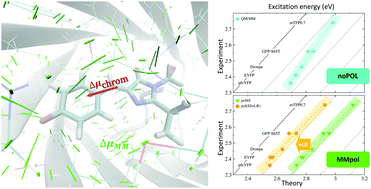The key to the yellow-to-cyan tuning in the green fluorescent protein family is polarisation†
Abstract
Computational approaches have to date failed to fully capture the large (about 0.4 eV) excitation energy tuning displayed by the nearly identical anionic chromophore in different green fluorescent protein (GFP) variants. Here, we present a thorough comparative study of a set of proteins in this sub-family, including the most red- (phiYFP) and blue-shifted (mTFP0.7) ones. We employ a classical polarisable embedding through induced dipoles and combine it with time-dependent density functional theory and multireference perturbation theory in order to capture both state-specific induction contributions and the coupling of the polarisation of the protein to the chromophore transition density. The obtained results show that only upon inclusion of both these two effects generated by the mutual polarisation between the chromophore and the protein can the full spectral tuning be replicated. We finally discuss how this mutual polarisation affects the correlation between excitation energies, dipole moment variation, and molecular electrostatic field.

- This article is part of the themed collection: 2019 PCCP HOT Articles


 Please wait while we load your content...
Please wait while we load your content...